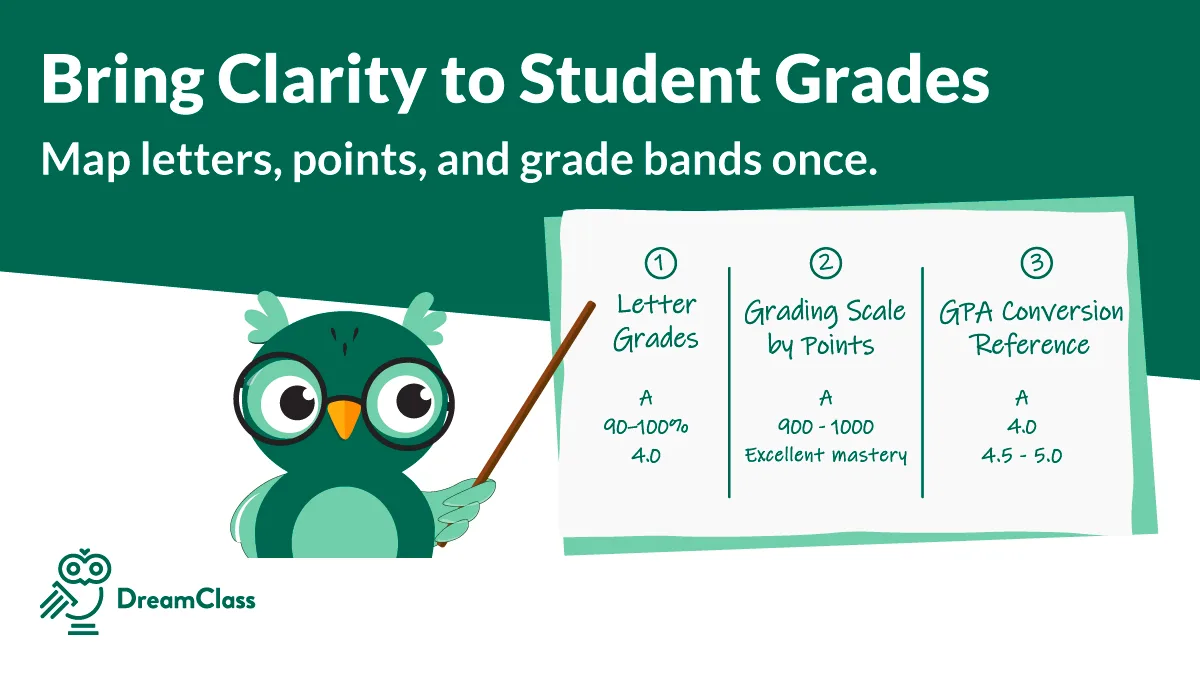
A gradebook scale is the set of rules that convert raw student results into final marks. It maps scores to grading scale letters (A–F), grading scale by percentage bands (e.g., 90–100% = A), grading scale by points (e.g., 900–1000 points = A), and to a grading scale GPA value (e.g., A = 4.0). In the US grading scale, bands vary by district or institution, so define, document, and consistently apply your scale, and make it visible to families and staff in your SIS.
Why this gradebook scale matters
Teachers and admins juggle letters, percentages, points, and GPA—and parents see a different number everywhere. Without a clear gradebook scale, the same 89.45% might “round” to a B+ in one class and an A– in another. That inconsistency confuses families, frustrates teachers, and complicates transcripts.
Standardize your gradebook scale once, then let your SIS do the math. With DreamClass, you can align letters, percentages, points, and grading scale GPA mapping; publish it through the parent portal; and keep everyone on the same page. For deeper gradebook tips, see How can online gradebooks simplify student grading in K‑12? and Make the most out of your teacher gradebook.
What is a gradebook scale?
A gradebook scale is the translation layer between raw performance and the official grade your school publishes. It creates a consistent bridge from classroom assessments to transcripts, so your team can defend decisions during parent meetings, audits, or accreditation reviews. And because accuracy and clarity reduce disputes later, it pays to define the policy in plain language, and make it easy to find in your SIS.
Now, before we walk through formats, it helps to clarify what exactly is converted, and where those conversions show up across reports. In most schools, the scale expresses three common mappings that administrators care about most:
- Numeric percentages into grading scale letters (A, B, C, etc.)
- Points totals into letters (e.g., 850–899 points = B)
- Letters into grading scale GPA values for transcripts (e.g., A = 4.0)
After you choose a policy, you might also decide whether you’ll use plus/minus, and document any exceptions for specific programs. Because policy implementation should be transparent, most schools may surface their rules through the teacher portal and academic management features. So, if your school uses decimals (e.g., 92.7), you might choose and communicate a “rounded” mapping standard. And, in case you’re wondering, DreamClass does support decimal grades; see Introducing decimal grades & more.
How does the US grading scale typically work?
There’s no single national standard; however, many schools follow familiar bands and adjust them locally. That flexibility is why documenting your policy, and publishing it to families and faculty, matters for trust. It also helps registrars and counselors maintain consistency across departments when, say, teachers prefer different scoring methods.
Grading scale letters (with common plus/minus)
Schools often pair letters with plus/minus thresholds to add precision and align to transcript conventions. The list below shows a widely used pattern you can adopt as‑is or tune to fit State guidance. As always, ensure your chosen bands appear in syllabi, portals, and transcript exports, so families see the same logic everywhere.
- A (Excellent): often 93–100; A–: 90–92
- B (Good): often 83–86; B+: 87–89; B–: 80–82
- C (Satisfactory): often 73–76; C+: 77–79; C–: 70–72
- D (Needs improvement): often 63–66; D+: 67–69; D–: 60–62
- F (No credit): often ≤59
Because districts and colleges may publish their own policies, your final letter bands might differ slightly. For reference, see examples from NCES and university registrars (e.g., NCES HSTS overview, ASU Registrar, University of Cincinnati Registrar).
Grading scale by percentage
A simple percentage policy promotes transparency and makes parent communication straightforward. It’s also convenient when your gradebook already calculates assignment weights and category totals. So, start with the classic bands below, then decide if you want to add plus/minus for finer distinctions; especially in competitive programs.
| Letter | Percentage Range |
| A | 90–100% |
| B | 80–89% |
| C | 70–79% |
| D | 60–69% |
| F | 0–59% |
After adopting a grading scale by percentage, you might publish the thresholds in your handbook and portals. Then, surface them in the student portal, so families can reconcile assignment scores with term grades. And, finally, maybe even consider mirroring the table in your department syllabi to reduce support questions.
Grading scale by points
Many programs prefer points (e.g., 1000 points per term) because teachers can express rubric totals more naturally. Points also help when you want to weigh large projects without revealing percentages to students. The table below gives you a clean baseline to start from:
| Letter | Points Range (out of 1000) |
| A | 900–1000 |
| B | 800–899 |
| C | 700–799 |
| D | 600–699 |
| F | 0–599 |
If you choose a grading scale by points, you might want to confirm how points convert to letters at course level, and also verify that transcript exports reflect the same mapping. DreamClass supports both percentage and points workflows; for background, see A new and improved gradebook calculator for teachers.
How is the grading scale GPA calculated?
Most US schools convert letters to an unweighted GPA on a 4.0 scale (A=4.0, B=3.0, C=2.0, D=1.0, F=0). Many also support weighted GPAs for Honors/AP/IB or advanced courses, adding 0.5–1.0 to the base value. The table illustrates both approaches and helps you standardize GPA across departments and transcripts:
| Letter | Unweighted GPA | Weighted GPA (Honors/AP example) |
| A | 4.0 | 4.5–5.0 |
| B | 3.0 | 3.5–4.0 |
| C | 2.0 | 2.5–3.0 |
| D | 1.0 | 1.5–2.0 |
| F | 0.0 | 0.0 |
To align with public data and registrar practice, you might want to see NCES: How GPA is calculated (HSTS) and recent registrar examples, such as UNC and University of Illinois.
Do you need a grading scale calculator or a gradebook scale calculator?
If your faculty uses different schemes (letters in English, points in STEM, percentages in PE), a calculator helps reconcile edge cases and custom bands. It also reduces spreadsheet sprawl and ensures the same policy drives both progress reports and transcripts. Better still, you can audit GPA outcomes quickly with exports and spot anomalies before grades are released.
Now, when you centralize the logic in your SIS, you gain consistency term after term. DreamClass bundles calculators in workflows you already use. If you need more information about that, see How to create a gradebook for students in DreamClass and How can an online gradebook help teachers and administrators? And if you need parent visibility by default, pair it with the parent portal.
Gradebook scale examples you can copy
OK. Before you pick a template, remember that clarity beats cleverness. Choose bands teachers can apply consistently, then lock your term settings so thresholds don’t drift. The three example lists below cover the most common needs: classic percentage bands, a precise plus/minus model, and a standards‑based points rubric. So, here we go:
Classic 90/80/70/60 (letters + GPA)
This baseline works well in K‑12 and entry‑level college courses because it is easy to communicate and audit. Parents understand the ranges at a glance, while faculty appreciate the simple GPA mapping. If you have competitive programs, you can shift the A band higher later, without rewriting the entire policy.
- A = 90–100% (4.0)
- B = 80–89% (3.0)
- C = 70–79% (2.0)
- D = 60–69% (1.0)
- F = 0–59% (0.0)
After adoption, you may post the table and these bullets in your handbook and portals, and confirm that every course syllabus echoes the same thresholds. For transcript integrity, ensure mid‑term reports, final reports, and exports all read from the same gradebook scale configuration. And, you guessed it, DreamClass can help with that kind of centralized approach.
Plus/minus system (greater precision)
Schools that want finer distinctions often layer in plus/minus. This helps scholarship committees and competitive programs reflect small differences near cutoffs, while keeping the overall philosophy familiar. Be sure to update GPA mappings to include minus and plus values on the transcript.
- A = 93–100; A– = 90–92
- B+ = 87–89; B = 83–86; B– = 80–82
- C+ = 77–79; C = 73–76; C– = 70–72
- D+ = 67–69; D = 63–66; D– = 60–62
- F = ≤59
Once enabled, you could publish a short “How we map and report” note in the student portal. If your registrar uses an A+ with 4.33 points, verify whether your cumulative GPA is capped at 4.0 like ASU, or follows a different policy.
Standards‑based variant (points bands)
Programs that emphasize mastery can keep familiar letters on transcripts, while using rubric‑aligned point bands internally. That way, teachers speak the language of standards daily, yet parents still see traditional marks on reports. The mapping below is a practical compromise that can work across subjects.
- 4 = Exceeds (900–1000 points)
- 3 = Meets (800–899)
- 2 = Approaches (700–799)
- 1 = Beginning (0–699)
When you adopt a standards‑based gradebook scale, you might consider pairing it with rubrics and exemplars, so students understand how to improve. But, confirm that progress dashboards and final exports reflect the same points↔letters logic. And, don’t forget to update department guides, so new teachers can implement the policy correctly, from day one.
Which gradebook scale fits K‑12, micro-schools, or higher‑ed?
Choosing the right gradebook scale depends on who you serve and how you report. K‑12 private schools often prioritize family clarity; micro-schools need flexibility for multi‑age cohorts; higher‑ed programs must satisfy registrar and accreditation requirements. The pointers below match common constraints to practical defaults.
- K‑12 private schools: Keep thresholds simple, publish them in the parent portal, and sync your progress reports with online gradebooks.
- Microschools: Use concise rubrics and a grading scale by points. Tag classes to keep multi‑age groupings tidy; also, see class and course tagging.
- Higher‑ed & vocational: Ensure grading scale GPA mappings are consistent across departments, and audit‑ready. Our college attendance management article and higher‑ed ERP overview may help.
After selecting your model, run a quick pilot in one department, export sample transcripts, and confirm GPA accuracy against registrar policy. Then, lock settings and communicate the final decision in your handbook, syllabi, and portals, so families encounter the same information everywhere.
This is a lot of information, we know. We’re almost done, though; let’s take a look at how to implement all that:
Implementation checklist for a reliable gradebook scale (quick wins)
Implementation succeeds when policy, communication, and exports stay in sync. A short checklist keeps teams focused on the steps that matter most, and prevents scope creep during grading periods. You can use the list below as your rollout plan for the current term, then revisit annually.
- Define your bands (letters, % or points).
- Set mapping rules (optionally).
- Map letters to grading scale GPA.
- Choose plus/minus.
- Configure by term and lock after census.
- Publish the policy in the student and parent portals.
- Test transcripts and exports.
- Train staff; our onboarding program helps.
- Communicate updates with notifications.
Once you complete the checklist, schedule a short post‑check with department leads. Capture exceptions you approved, questions families asked, and any transcript issues. You can feed those findings into the next policy update, so your gradebook scale improves each term, without surprising teachers or parents.
Download the Gradebook Scale Cheatsheet
Use it as a benchmark, share it with staff, attach it to teacher onboarding packets, or post it in your parent portal.
Or scan the QR code below:

What schools say
Educational Programs will LOVE DreamClass!
DreamClass allows our educational program to have a one-stop solution for registration, attendance, communication, gradebook, and calendar events! It has been a huge blessing to Anchor Enrichment Academy and we have enjoyed the setup process.
DirectorEducation management
Great option for small schools!
One stop shop for gradebook, parent communication, school calendar, announcements, and invoicing. I love the customer service and the easy to use platform and it can be customized for your individual school. When issues have come up, the support team will get on a call with you and show you how to navigate or fix any issue you are having.
PrincipalReligious institutions
Review of Dreamclass
DC is great for organizing and sharing student records. At first, DC had some templates for school records (gradebooks, schedules, etc.) that make sense for most schools, but didn’t make sense for us since our school functions slightly differently from most. However, DC was able to accommodate our needs by making small adjustments that made a big difference for us.
Artistic DirectorMusic
For more real‑world feedback, visit our Customer Reviews.
Ready to standardize your gradebook scale?
Book a free demo to see how fast you can implement a consistent gradebook scale that keeps teachers, families, and accrediting bodies aligned.
FAQ
Frequently Asked Questions
about grading scales
What’s the difference between grading scale by percentage and points?
Percentages express performance on a 0–100 scale; points tally raw scores toward a total (e.g., 850/1000). Both map to letters. Typically, you would choose one primary method, and document the conversion.
How do plus/minus grades affect grading scale GPA?
If enabled, plus/minus adds precision (e.g., A– = 3.7). But you should keep the policy consistent across departments and reflect it in transcripts.
Can we have different scales by course or department?
Yes, if you document them and communicate them clearly in your syllabus and portals. Also, remember to centralize the mappings, so transcripts remain consistent.
What happens if we change the scale mid‑term?
Avoid it. But, if you must, communicate the effective date and apply the same rules to all students in that course and term. Lock term settings once grades are finalized.
Do you offer a grading scale calculator?
DreamClass includes built‑in calculators within gradebook and transcript workflows. See our gradebook calculator update and related posts.





